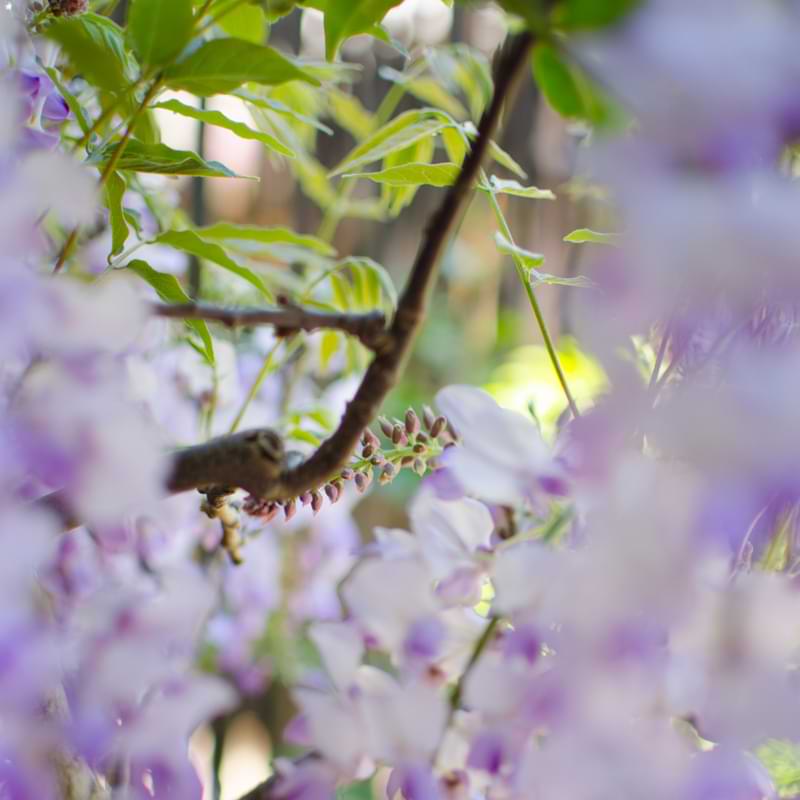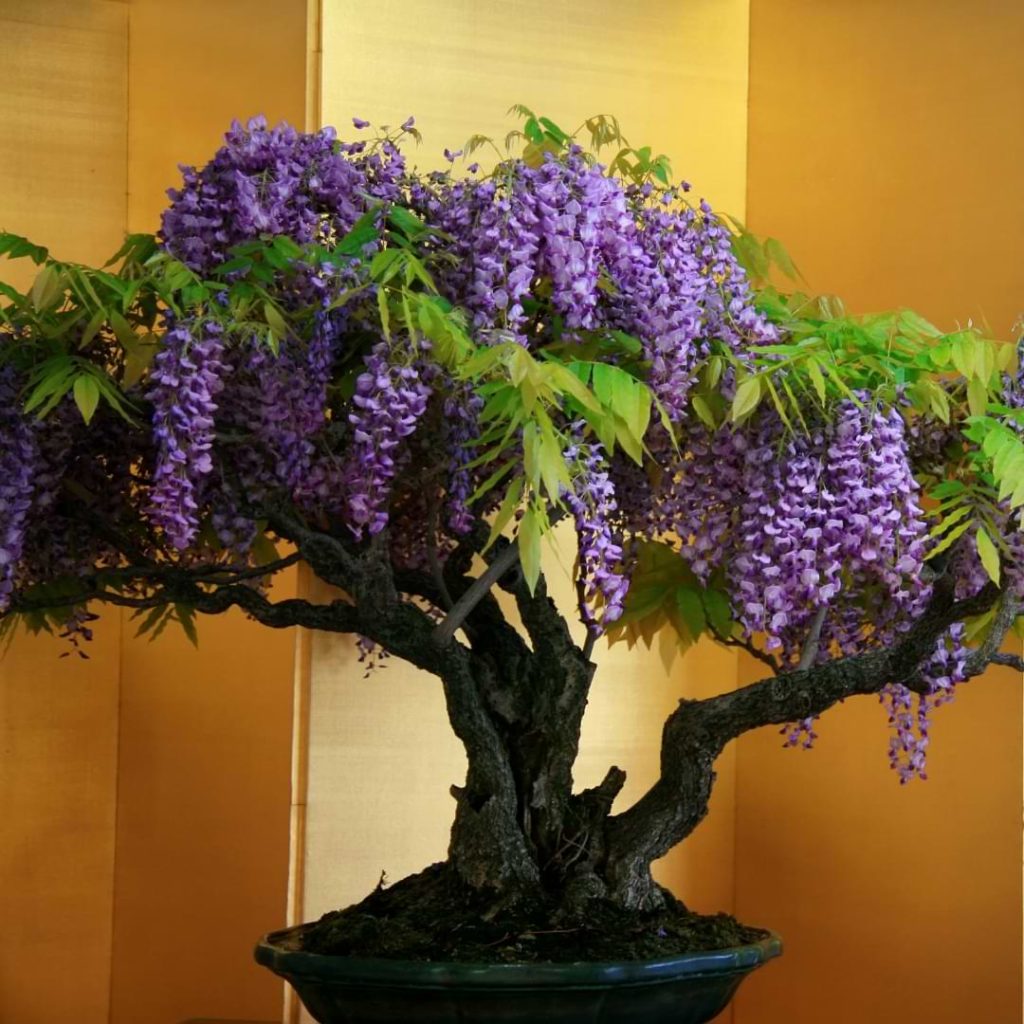There’s nothing like seeing a wisteria plant in full bloom. Come spring, these fast-growing vines erupt with fragrant, cascading clusters of bluish-purple blossoms. And in the world of flowering bonsai, the wisteria is held in high regard.
These tiny powerhouses are vigorous and rewarding to grow, making a proud display in any bonsai showroom. In the wild, the seed pods grow long and velvety—and literally explode when it’s time to seed. This leads many bonsai enthusiasts to wonder about growing wisteria bonsai from a seed.
Taking any bonsai from seed to specimen is a major task, and it can be a little overwhelming getting started. But never fear, this Guide to Growing Wisteria Bonsai From Seeds will tell you everything you need to know!
Guide to Growing Wisteria Bonsai From Seeds
While it can be easier (and quicker!) to take over the care of a mature, established bonsai, many growers are eager to nurture their tree from its earliest stages. Growing wisteria bonsai from seeds isn’t challenging, you just need to know how to provide the correct conditions—and a whole lot of patience.
It can take from 10 to 15 years for bonsai grown from seed to reach maturity. That means a lot of time will pass before you get blessed with their beautiful blooms. But we promise, if you’re willing to wait, it’s worth it!
Let’s take a closer look at how to germinate wisteria seeds, and a few common beginner FAQs.
A note: Chinese and Japanese wisteria are considered invasive species in the mid-Atlantic and Southeastern United States. If you’re growing in these regions, take extra care to contain your seeds or you risk harming native flora and fauna.
How to Germinate Wisteria Seeds
Growing wisteria bonsai from a seed isn’t as simple as tossing some seeds in a pot. First, you’ll need to encourage the seeds to germinate, or push out roots. This is how you tell which seeds are viable and give them a little starter boost.
- Step 1: Harvest the seeds from the pod of a blooming wisteria plant. Shake the wisteria pod to see if the seeds are dry enough to harvest. If it makes a rattling sound, you’re good to go.
- Step 2: Not all harvested seeds will be viable. Determine which seeds will sprout in the future by placing in a container of water; those that sink are viable.
- Step 3: If sowing dried seeds, weakening the outside of the seed can help the embryo germinate. Consider slightly thinning the shell with a file or sharp blade before sowing.
- Step 4: Fill a large, shallow pot or several individual seedling containers with moist, soilless seedling mixture (containers must have drainage holes).
- Step 5: Place the seeds on top of the soil, cover with a thin layer of soil, and water well. Place in a well-lit, temperate location.
- Step 6: Wisteria plants love a moist environment, particularly in their early stages. Check soil moisture levels daily, keeping the soil moist but not waterlogged.
- Step 7: Once wisteria seedlings sprout above the soil, you can move to a well-draining, shallow pot to begin the bonsai process.
FAQ 1: How do you look after bonsai seedlings?
Once your seedling has been transplanted to a shallow pot, you’ve still got plenty of work ahead before you achieve the “bonsai effect.” First, you’ll need to practice proper soil maintenance so the delicate wisteria roots can grow as strong as possible.
A layer of coarse substrate or coco peat at the bottom of the pot helps promote water retention while allowing adequate air flow. Atop this layer, fill the rest of the pot with conventional bonsai potting soil. Once you’ve planted your bonsai seedling in this mixture, give it abundant sunlight to promote photosynthesis and power new growth.
FAQ 2: How often do you water bonsai seedlings?
Wisteria bonsai seedlings need a lot of water during their growing stages, and like to stay perpetually moist. Check moisture levels daily and water at least once per day. Your objective is to keep the soil damp but not waterlogged—and never let it dry out.
To allow the bonsai seedling to manage its own moisture uptake, you may place its container in a shallow tray of water.
Learn more: See our guide How to Know When to Water Your Bonsai for what to look for before bath time.
FAQ 3: When should I repot my bonsai seedlings?
The best time to transplant bonsai seedlings is in late winter, when the plants have gone completely dormant. This reduces shock and stress from the repotting process. Wisteria plants are fast-growing and vigorous, and can easily be ready for repotting after just one growing season. As they mature into juvenile trees, you’ll need to repot once every two years or so to accommodate new growth.
Learn more: See our Guide to Repotting Your Bonsai Tree for step-by-step instructions.
FAQ 4: Is it hard to grow a bonsai tree from seed?
It’s not hard to grow a wisteria bonsai—or any type of bonsai for that matter—from seed. If you provide a proper environment, most viable seeds stand a good shot of starting the long journey toward bonsai greatness. It does, however, take an abundance of patience. It can take around 10 to 15 years for a seed to grow into a mature bonsai, with the trimming and pruning process starting around year 4.
FAQ 5: How long does a wisteria bonsai take to grow?
As a vine, the wisteria bonsai grows rapidly and flowers quickly. But as a bonsai, these natural processes slow down substantially. From seed, it can take about a decade for a Wisteria bonsai to produce its trademark bluish-purple blooms. That’s why many growers opt to buy an established tree from a bonsai nursery. But should you sign up for the long haul, we promise—it’s worth the wait.

How to Make a Wisteria Bonsai Tree
Whether you’re growing wisteria bonsai from a seed or purchasing a juvenile specimen, you’ll need to master a few techniques to achieve the trademark “bonsai effect.” From day one, you’ll want to provide the prime conditions for growth, which we’ll get into below.
As your tree continues to grow, proper pruning and wiring will be your best friends. Wisteria are a resilient species, and can endure more cutting and shaping than a standard bonsai tree. Follow these best practices:
Prime Wisteria Bonsai Conditions
At all stages of its life, wisteria bonsai will appreciate generous amounts of water and full sunlight during the growing season. These species are particularly amiable to pots placed in a bowl of water. They’re frost-tolerant when planted in the ground, but be sure to offer the added protection of a shed or grow room if they’re planted in a pot. If overwintering outdoors, avoid soaking the roots as this risks frostbite.
Pruning a Wisteria Bonsai
Wisteria bonsai grows quickly, and will need regular pruning throughout the growing season to control runaway limbs and foliage; at the peak, you may even want to give a weekly or daily “trim.” If you have a mature tree, wait until it blooms in early spring to perform hard pruning.
Allow the canopy and tendrils to grow into the midsummer months and prune back and thin as needed. (Remember, never fully defoliate a wisteria bonsai because the leaves won’t grow back!) Later in the year, once your tree has dropped its leaves, perform structural pruning. Take care to leave flowering buds intact for the next season.
Wiring a Wisteria Bonsai
This flexible, fast-growing vine species is quite tolerant of wiring, but you’ll need to do it at the end of growing season to prevent strain and breakage. The purpose of wiring a wisteria bonsai is to position the branches in the shape in which you’d like them to grow the following season. See 6 Steps to Wiring Bonsai for an easy starter’s guide.
Types of Wisteria Bonsai Tree
Unlike some massive tree genuses, the wisteria genus is made up of just nine (or so) individual species. Of the family, the Japanese wisteria and Chinese wisteria are by far the most popular for backyard and bonsai growing.
Japanese Wisteria Bonsai (Wisteria Floribunda)
The Japanese wisteria produces the longest flower clusters of all the wisteria species—which is one reason why it’s so popular for bonsai. Once it’s mature enough to bloom, your tree will produce stunning blue-violet or red-violet blooms cascading from its branches. Be aware: the tree grows rapidly, and will need consistent pruning.
Chinese Wisteria Bonsai (Wisteria Sinensis)
The next most popular wisteria in bonsai, Chinese wisteria are beauties in their own right. Similar in appearance to Japanese bonsai, they have slightly shorter clusters, which bloom in bluish-purple hues. Once mature, your bonsai will produce a gorgeous, fragrant display from May to June. Fast-growing (it’s a vine!), your Japanese wisteria bonsai will need regular pruning to maintain its bonsai form.
Still curious about growing wisteria bonsai from a seed? Drop your burning questions in our Facebook group.
Bonsai With Us!
The Bonsai Resource Center is here to help you learn how to make a bonsai tree and provide you with the tools you need to keep your tree healthy and strong. Explore our other articles, visit our online shop, and connect with other bonsai lovers in our Facebook group to learn everything you need to know about this rewarding hobby!
More Bonsai Tree Resources
6 Easy Steps to Wire Bonsai Trees
Growers Guide: How to Make a Bonsai Tree



